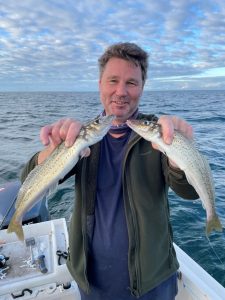
Adrian Cole shows the quality of whiting currently on offer. These were caught off St Leonards (Picture: Mark Sesar).
Off the beach
Early last week, Ray Millman fished at Jan Juc from dusk onwards. All he caught initially were several Whitley skates, one of which was a huge specimen some 1.5 metres across the wings that took a silver trevally Ray had foul-hooked then fished as a live bait. And, because of its size, releasing that one, as he did the others, proved something of a challenge.
Following that episode, Ray was rewarded, first with a 2.5 kg Australian salmon, followed by a another much smaller, the fillets of which he used for bait. His first capture being an elephant fish of possibly 4 kg that he released, and then a bronze whaler of just over a metre in length that he kept, along with the larger salmon.
Corio Bay/Bellarine Peninsula
Launching from St Leonards on Sunday afternoon, Mark and Tina Sesar, and Adrian Cole, found a good patch of squid from which they were able to extract a dozen despite the stiff sou-westerly that saw only a few boats on the water. And, with the incoming tide aligning with the breeze, they anchored up in six metres of water hopeful of catching a few whiting.
They finished up with 30 good size whiting as it turned out, but – with the weather worsening toward evening – they made tracks.
Early last week, Andrew Johnson was on the water by 6.30 am down Curlewis way in one of his usually productive whiting spots. However, with nothing doing for half an hour, he was on the move again, eventually finding a good patch of fish back toward the mussel farm off Clifton Springs in six metres of water. And it was from here that he took a bag limit catch of whiting from 34 to 42 cm.
With the day still young, he broke out the squid jigs and was initially greeted by a plethora of pea-dodgers, which he released, eventually finding a patch of bigger ones, taking ten; some for bait and others for the table.
Making an early start just offshore from the entrance of Swan Bay on Wednesday morning, Andrew Phillips and Tony Greg’s first order of business was to catch some squid, and – despite the drizzling rain – they kept at it and eventually took bag limit catches that included one of 1.5 kg. And, with still a fair amount of run on the outgoing tide, they anchored up near Coles Beacon hopeful of catch a few whiting before the tide was finished.
They caught 35 good size specimens by the time the tide had died at around 11.00 am, their biggest measuring 43 cm. But by then, the weather had worsened with the westerly picking up from 15 to 20 knots on their return trip.
Rod Ludlow of Beachlea Boat Hire at Indented Head reports that whiting, some over the 40 cm mark, and squid, both put in welcome appearances for clients, some of whom were out in indifferent weather during the week, but – for the main part anyway – returning with smiles on their faces.

Melbourne angler Paul Carbis unhooks one of 30 redfin he caught from Lake Purrumbete (Picture: John Clements).
Freshwater
John Clements of Lake Purrumbete Holiday Park reports that fishing is good from the lake, especially for redfin which seem to be the main drawcard, although Aaron Goral of Eltham managed to add a smallish tiger trout to his tally.
Melbourne angler Paul Carbis caught 30 odd redfin on scrubworms, while George Gillies from Winchelsea took a similar catch using live minnow for bait.
Chinook salmon are also on offer for those seeking them. With some – those that were released as fingerlings, and not as yearlings, which is the norm – now around the 4 kg mark: Hopefully this practice will continue.
Sam asks:
Geoff, can you enlighten me as to the meaning of “salt wedge” when applied to estuaries, and its effect on fish?
Sam, my understanding of a salt wedge estuary, is that salt water coming in from the sea, being denser than the fresh water coming down the river, in conditions of reduced flow, has the potential to form a layer beneath the fresh.
Under these conditions, this layer tends to be roughly wedge-shaped with the thin edge beginning at the bottom some distance upstream from the mouth, gradually expanding toward the sea where the water is usually salt from top to bottom.
Should an estuary become closed to the sea and stagnant, delineation between salt and fresh becomes more distinct, the deepest levels becoming oxygen-depleted and toxic. So, any significant delay in opening such an estuary to the sea increases the propensity for this toxic layer to mix with, and poison, the formerly habitable layer.
